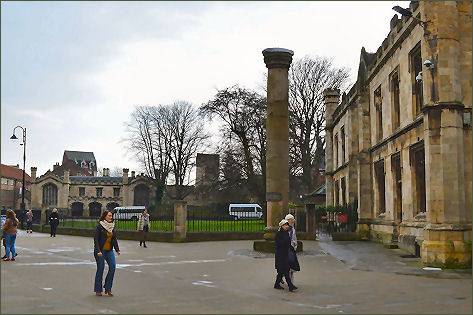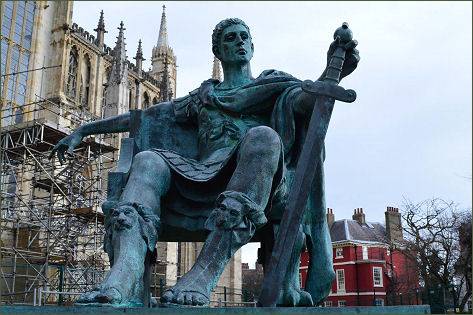Minster Close
York Minster was once contained in a large walled area which was known as the Liberty of St. Peter. The Minster authorities held legal and judicial powers in this area. Now known as the Minster Close it contains some interesting buildings connected with the history of the Minster.


Opposite the south door of York Minster stands a tall gritstone column, which once formed part of the arcade of the large Roman Basilica or Great Hall which occupied on site of York Minster. The column, which rises to 22 feet, was discovered lying on its side in the foundations of the Minster during an excavation of 1967 to 1972 and provides a good impression of how significant a building the Basilica would have been. There were originally 16 such columns in the building and it is believed that it would have been where the Emperor Constantine was declared Emperor of Rome in York, or Eboracum as it was then known in AD 306. The foundations of the Basilica may be seen in York Minster's Undercroft museum.
Other Roman remains still to be seen in York include the Multangular Tower, located in the western corner tower of the Roman fortress, standing 9 metres high, which can now be seen in the York Museum Gardens, the Roman Bath Inn, and an impressive collection of finds displayed at the Yorkshire Museum.
A large seated statue of the Emperor Constantine by the renowned sculptor, Philip Jackson stands opposite the column, it was commisioned in 1998 by York Civic Trust. In 306AD, Constantine was visiting the Roman fortress at York when his father died. The Sixth Legion immediately hailed Constantine the next Emperor of the West. This is most likely to have occured in the basilica.
Constantine, one of the most remarkable of the Roman Emperors and the founder of Constantinople, was the first emperor to stop Christian persecutions and to legalise Christianity along with all other religions and cults in the Roman Empire. The traditional site of his crowning is preserved under York Minster.
Medieval St William's College, a Grade I listed building, is situated in College Street, to which it bestowed its name and stands in the shadow of the Minster. The black and white timber framed frontage of the building is decorated with several interesting features, including oak carvings, coats of arms, and a sundial. The building's main door has a mouse carving by Robert Thompson, the famous 'Mouse Man of Kilburn'. The college was built in 1465 for the Minster's Chantry Priests, who were paid to pray for the souls of the dead.
Dean's Park, a favoured spot of visitors to York in the summer months, is a pleasant, green open space situated to the north side of York Minster which provides superb views and excellent photo opportunities of the Minster buildings. Originally the park housed the Old Palace of the Archbishops of York which dated back to the twelfth century.
Guide to the Streets of York
| Coney Street | Coppergate | Fossgate | Goodramgate |
| Minster Close | Pavement | Petergate | The Shambles |
| Snickelways of York | Stonegate |
